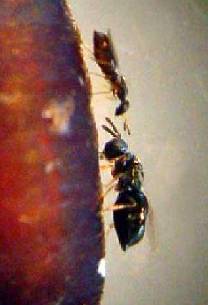

ABSTRACT:In this investigation, students first design experiments to examine intraspecific and interspecific competition using two
species of parasitoid wasps. Second, students are guided to a consensus experiment that examines the effect of both types of competition
on reproductive output in the parasitoids. Third, the students conduct the consensus experiment in which one or two females are placed
on a single host, alone, with conspecific competitors, or with interspecific competitiors. In subsequent labs, students check cultures for
emergence of new adults. Six weeks later, students gather data on the number of offspring produced by females under each of the initial
densities of founding females. The resulting data are used to estimate the parameters of the Lotka-Volterra competition model. The predictions
of the model are then compared to the outcome of interspecific competition treatments. Information is also included on using the appropriate
statistical analyses to compare the relative importance of interspecific and intraspecific competition on offspring production. AUTHORS:Christopher W. Beck 1, Judy A. Guinan 2, Lawrence S. Blumer 3, and
Robert W. Matthews 4
1 - Emory University, Department of Biology, 1510 Clifton Rd., Atlanta, GA 30322, 404-712-9012, 404-727-2880,
cbeck@emory.edu ___________________________________________ CLASS TIME:This study requires two 3-hour lab periods and weekly, short observation periods in between. In an initial, 3-hour lab period,
students work in groups to design experimental treatments and then are guided to establish experimental cultures. Then, students
examine cultures weekly for first emergence of new adults. Cultures are frozen after full emergence, approximately 21 days for Nasonia
cultures and 40 days for Melittobia and mixed species cultures. In a second, 3-hour lab period, students count the offspring produced in
each experimental culture and then discuss the analysis of the resulting data. OUTSIDE OF CLASS TIME:Students may spend several hours analyzing their data and writing papers based on their results. STUDENT PRODUCTS:Students prepare written scientific papers based on the pooled data from the entire class. SETTING:The experiment is carried out entirely in the lab. A field component could be added to have students look for parasitoid
wasps in their natural habitats (i.e., mud dauber nests). COURSE CONTEXT:The experiment as described is used in upper-level ecology courses with a maximum of 24 students per lab section. INSTITUTION:The experiment has been implemented successfully at a small private college, a mid-size private university, and a
mid-size public university. TRANSFERABILITY:A version of this experiment has been implemented successfully in an introductory biology course for non-majors at a
large public university by emphasizing qualitative comparisons of the effects of intraspecific and interspecific competition. The version
for introductory biology was presented as a major workshop at the annual meeting of the Association for Biology Laboratory Education
(ABLE) and will be published in the proceedings of the conference in June 2005. This version of the exercise does not include examination
of the Lotka-Volterra competition model, but involves more qualitative analysis of the results. Prior to publication in the proceedings,
the version for introductory biology is available from the authors. The study organisms used in this experiment are used for other activities
at the pre-college level. ACKNOWLEDGMENTS:
The original concept for this activity and first prototype version was written by Robert W. Matthews. This work was supported by a National
Science Foundation grant #0088021 to Robert W. Matthews. Jorge M. González was instrumental in organizing tests of this experiment
at various institutions. Bill Nelson also participated in testing a related experiment in large non-majors biology classes at the University of Georgia.
Leif Deyrup, Christian Torres, and Frank West collected much of the preliminary data on which this experiment is based.
A version of this lab for introductory biology was presented as a major workshop at the annual meeting of the Association for
Biology Laboratory Education (ABLE) in 2004 (www.zoo.utoronto.ca/able/conf/able2004/abstracts.htm) and will be published in the proceedings of the conference in June 2005.
This submission has benefited from comments by TIEE Editors and an anonymous reviewer.
CITATION:Beck, C. W., J. A. Guinan, L. S. Blumer, R. W. Matthews. August 2004, posting date. Exploring the Lotka-Volterra Competition Model using Two Species of Parasitoid Wasps. Teaching Issues and Experiments in Ecology, Vol. 2: Experiment #1 [online]. http://tiee.ecoed.net/vol/v2/experiments/wasps/abstract.html |

parasitic wasps Melittobia digitata (above) and Nasonia vitripennis (below) on their host Neobellierria pupa
© Jorge M. González, full size image |
<top> | |